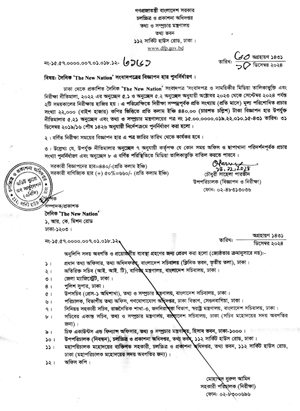Health Desk :
Countries around the world are scrambling to halt the spread of the coronavirus pandemic.
As of June 4, more than 386,000 people worldwide have died of COVID-19, the highly infectious respiratory disease caused by the coronavirus.
The number of people who have tested positive for COVID-19 has exceeded 6.5 million, according to data compiled by Johns Hopkins University. At least 2.8 million people have recovered.
According to the World Health Organization (WHO), coronaviruses are a family of viruses that cause illnesses ranging from the common cold to more severe diseases such as severe acute respiratory syndrome (SARS) and the Middle East respiratory syndrome (MERS).
These viruses were originally transmitted from animals to people. SARS, for instance, was transmitted from civet cats to humans while MERS moved to humans from a type of camel.
Several known coronaviruses are circulating in animals that have not yet infected humans.
The name coronavirus comes from the Latin word corona, meaning crown or halo. Under an electron microscope, the virus looks like it is surrounded by a solar corona.
The novel coronavirus, identified by Chinese authorities on January 7 and since named SARS-CoV-2, is a new strain that had not been previously identified in humans. Little is known about it, although human-to-human transmission has been confirmed.
COVID-19 what’s in a name
What are the symptoms?
According to the WHO, signs of infection include fever, cough, shortness of breath and breathing difficulties. Other signs include loss of taste or smell as well as muscle aches.
In more severe cases, it can lead to pneumonia, multiple organ failure and even death.
Current estimates of the incubation period – the time between infection and the onset of symptoms – range from one to 14 days. Most infected people show symptoms within five to six days.
However, infected patients can also be asymptomatic, meaning they do not display any symptoms despite having the virus in their systems.
The number of fatalities from the new coronavirus has overwhelmingly surpassed the toll of the 2002-2003 SARS outbreak, which also originated in China.
SARS killed about 9 percent of those it infected – nearly 800 people worldwide and more than 300 in China alone. MERS, which did not spread as widely, was more deadly, killing one-third of those infected.
While the new coronavirus is more widespread than SARS in terms of case numbers, the mortality rate remains considerably lower at approximately 3.4 percent, according to the WHO.
According to the Centers for Disease Control and Prevention (CDC), older people are at higher risk for severe illness from COVID-19 which may result in increased stress during a crisis.
People who have severe underlying medical conditions like heart or lung disease or diabetes also seem to be at high risk for developing more serious complications from COVID-19 illness.
Where have cases been reported?
Since March 16, more cases were registered outside mainland China than inside, marking a new milestone in the spread of the global pandemic.
The virus has spread from China all around the world, prompting the WHO to label the COVID-19 outbreak a pandemic.
Human-to-human transmissions became evident after cases were recorded with no apparent link to China.
What is being done to stop it from spreading?
Scientists around the globe are racing to develop a vaccine but have warned it is not likely one will be available for mass distribution before 2021.
Meanwhile, a growing number of countries have introduced a series of sweeping measures to slow the spread of the coronavirus, including nationwide lockdowns, bans on gatherings, closure of schools, restaurants, bars and sports clubs, as well as issuing mandatory work-from-home decrees.
International airlines have cancelled flights the world over. Some countries have banned non-citizens from entering their territories, and several more have evacuated their citizens from abroad.
Where did the virus originate?
Chinese health authorities are still trying to determine the origin of the virus, which they say likely came from a seafood market in Wuhan, China where wildlife was also traded illegally.
On February 7, Chinese researchers said the virus could have spread from an infected animal species to humans through illegally-trafficked pangolins, which are prized in Asia for food and medicine.
Scientists have pointed to either bats or snakes as possible sources of the virus.
Is this a global emergency?
Yes, this outbreak is a global health emergency, the WHO said on January 30, raising the alarm further on March 11 when it declared the crisis a pandemic.
The international health alert is a call to countries around the world to coordinate their response under the guidance of the WHO.
There have been five global health emergencies since 2005 when the declaration was formalised: swine flu in 2009, polio in 2014, Ebola in 2014, Zika in 2016 and Ebola again in 2019.
Are smokers more likely to be at risk from coronavirus?
Smoking can make people more susceptible to serious complications from a coronavirus infection, the European Union agency for disease control said.
In its updated assessment of the risks caused by the coronavirus, the European Centre for Disease Control and Prevention (ECDC) included smokers among those potentially most vulnerable to COVID-19.
Smokers have also appeared to be more susceptible to breathing complications caused by the disease, and the ECDC said it was advisable to identify them as a potential vulnerable group, confirming an earlier assessment.
corona social cards
The agency cited a study by Chinese doctors which on a sample of 99 patients affected by the coronavirus found that acute smokers were more at risk of dying than elderly people.
The ECDC report also said smoking was associated with heightened activity in the lungs of an enzyme, ACE2, that could make patients more vulnerable to COVID-19, citing a study conducted by Guoshuai Cai, from the University of South Carolina.
The activity of ACE2, or angiotensin-converting enzyme 2, also increases with age and with some kinds of hypertension treatment – both risk factors – the ECDC said.
Source: Al Jazeera and news
agencies




